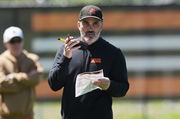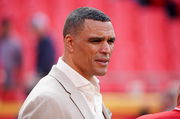
Imago
Credits: Instagram/ TCS NYC Marathon

Imago
Credits: Instagram/ TCS NYC Marathon
The world’s most electric marathon is set to return as the 2025 TCS New York City Marathon takes over all five boroughs on Sunday, November 2, 2025. Starting at Fort Wadsworth on Staten Island, the day will open with the wheelchair and handcycle divisions, followed by the professional women’s and men’s races, and then five mass-start waves beginning at 9:10 am. As the city readies for 26.2 miles of endurance, emotion, and euphoria, here’s everything runners and fans need to know before race day.
Watch What’s Trending Now!
1. How Can Runners Reach the Start Line on Race Morning?
The New York Road Runners operate the Staten Island ferry and the shuttle bus system. Runners can board the free Staten Island Ferry at Whitehall Terminal (Manhattan) to St. George, then transfer to NYRR buses that run directly to Fort Wadsworth. And the estimated travel time is just 90 minutes. There are also NYRR charter bus departures from Midtown Manhattan and select New Jersey locations (e.g., MetLife Stadium lot), and MTA service advisories are posted for race day. And the buses transport the participants directly to Fort Wadsworth in 60-90 minutes. All they have to do is show up 15 minutes early.
ADVERTISEMENT
But wait… There will be some security checks. Only the official clear start-village bag, which is distributed at the expo, is permitted into Fort Wadsworth. And all other bags are prohibited and subject to inspection. NYRR’s pre-check and bag-drop system requires runners to choose between a bag-check or no-bag (poncho) option before race day. Bag-check runners will have to drop their labeled clear bags at the start village trucks, while no-bag runners will receive a post-race poncho at the finish.
For timing, corrals open well before the wave starts. Hence, you’d have to plan to be at your ferry or bus boarding point well ahead of the departure schedule, before the wave to clear security, board transport, and reach your corral. Typically, it takes about 90-120 minutes from arrival to boarding. More detailed information will be given in your runner’s guide.
Top Stories
Footage Surfaces of Puka Nacua’s Brother Samson Slapping Fan After Arrest for Allegedly Stealing Lakers’ Adou Thiero’s SUV

Browns & Kevin Stefanski Sign Ousted Cowboys Player For Shedeur Sanders Before Week 16 Bills Game

“What Do You Come Back For?”: Tony Gonzalez’s Strong Retirement Message to Travis Kelce Amid Chiefs’ Rebuild

Carlos Alcaraz’s Split With Coach Resulted From ‘Major Disagreements’ With His Father

Controversial Crew Chief Finds Fresh Start With 17-Yo NASCAR Team

Simone Biles and Jonathan Owens Receive PETA Letter Over Pet Care Concerns

ADVERTISEMENT
2. What Should You Know About the 2025 New York City Marathon Course?
The marathon stretches on a 26.2-mile route that traverses all five boroughs. The race starts at Fort Wadsworth, Staten Island, where runners will tackle an immediate climb over the Verrazzano-Narrows Bridge. While the starting point provides a mesmerizing view of the NYC skyline, the runners will also have to face some strong crosswinds. The route then flows into Brooklyn, covering roughly 11 miles of lively, flat streets packed with cheering crowds. Crossing the Pulaski Bridge would mark the halfway point and entry into Queens, where pacing can become critical before facing one of the toughest climbs. A flat climb of 15-16 miles on the Queensboro Bridge that will lead the runners to Manhattan’s First Avenue.
After the roaring energy of Manhattan, runners will have to cross the Willis Avenue Bridge into the Bronx. It’s a short yet mentally testing section with smaller crowds and rolling roads. The Madison Avenue Bridge will bring the participants back into Manhattan for the final stretch down Fifth Avenue. And that’s the final challenge of the marathon. It’s a steady uphill grind before turning into Central Park for the final, emotional mile to the finish line.
ADVERTISEMENT
View this post on Instagram
But will you have to be wary of the weather?
ADVERTISEMENT
3. What Will the Weather Be Like for the New York City Marathon 2025?
According to the forecasts, we can expect early morning lows of around 45°F (about 7°C), rising to a high of about 54-56°F (12-13°C) by midday. There are chances of a light breeze across the course, running roughly 6mph from the west. Meanwhile, humidity is expected to be moderate (around 75 %) early on, with only about a 20% chance of rain and generally partly cloudy skies throughout.
Needless to say, these conditions are pretty ideal for a marathon. There’s a cool start with minimal risk of precipitation. However, the marathoners would still have to prepare for the chill on the bridges and wear layers that they can discard throughout the course.
ADVERTISEMENT
4. How Do the Start Corrals and Waves Work in the New York City Marathon 2025?
Precision and timing define the TCS New York City Marathon long before the starting gun goes off. With more than 50,000 runners storming the streets of all five boroughs, the 2025 edition relies on a meticulously engineered wave and color corral system to keep the world’s biggest marathon running like clockwork. And the bib numbers are the marathoners’ personal roadmap.
The bib is the determinant of the runners’ wave and one of the three color zones. Blue runners will begin on the upper deck of the Verrazzano-Narrows Bridge, taking in sweeping Manhattan views. Orange runners will also start on the upper deck but will follow a central route down Fourth Avenue in Brooklyn, while Green runners will begin on the lower deck, protected from winds but with a narrower path. By Mile 8, all three zones will merge, uniting thousands into one unstoppable marathon wave.
Runners are seeded by verified qualifying or estimated finish times, ensuring that those with similar paces start together. It’s a key detail that prevents early crowding and helps maintain rhythm from the first stride. Corrals usually open about 45 minutes before each wave and close about 15-20 minutes before the start. Miss your corral, and you’ll be reassigned to the next available wave.
ADVERTISEMENT
Now, let’s talk about the hydration and aid stations located throughout the NYC Marathon.
5. Where Are the Hydration and Aid Stations Located in the New York City Marathon 2025?
If you’re worried about the aid stations, you can leave all your worries. NYRR has confirmed that fluid stations with water and Gatorade are placed consistently throughout the course. And the distance? 3-25 miles. The organizers also provide energy gels at 12-18 miles. On top of that, medical tents and trained medics are staged at strategic points at set intervals. With Abbott heading the event, medical help will be readily available. So, there wouldn’t be any injuries unacknowledged. But can the runners’ families and friends keep track of them? Of course, they can!
ADVERTISEMENT
6. How Can Family and Friends Track You on Race Day?
People can use the official TCS NYC Marathon app (NYRR) for live runner tracking by bib. Yes, that’s another perk of the bib number. The application promises an interactive spectator guide to help users through the course of the marathon and track their favorite runners. There are also live course cameras to watch the runners cross the start, finish, and key spots along the 26.2-mile course.
ADVERTISEMENT
7. What Should You Eat and Drink Before the Race?
If you’re planning to run the race, you should focus on a carb-loading strategy two days prior to the race. This will maximize the glycogen stores, keeping the body ready for an endurance challenge. The priority should lie in familiar food as well. For example, load up on rice, pasta, potatoes, etc, paired with some lean proteins and minimal fats. After all, this isn’t the time to experiment. The meals have to be simple, balanced, and consistent with what worked in training.
On the morning of the race day, it’s recommended to eat a light, easily digestible breakfast a couple of hours before the start. You can think about oatmeal with banana, toast with peanut butter, or a trusted energy bar. And make sure to drink about 300-500ml of water with electrolytes beforehand. It’s advisable to sip small amounts of an electrolyte solution while waiting for the corral.
8. What Should You Expect After Crossing the Finish Line?
A short and straight answer to that? It’s going to be emotional and exhausting. With the thrill of the race still active, MarathonFoto will get your picture and video. So don’t forget to keep your bib clean and clear, with a bright smile on your face. Soon after that, you’ll get your medal for the finish and a recovery poncho. And yes, the poncho will be available to those who selected the no-bag option. But things aren’t over yet! There’s still a mile to walk to get to the exit of Central Park.
View this post on Instagram
Runners who chose the bag-check option can retrieve their belongings on Central Park West between West 69th and 70th Streets, open until 7:00 pm. After that, the unclaimed bags will be sent to the NYRR RunCenter for pickup the next day. And then it’ll be time for a reunion. The official Family Reunion area will be set up from West 63rd to West 66th Streets, divided alphabetically. Each entry point will include bag screening, so families should travel light and plan to arrive 20-30 minutes after their expected finish time, since the walkout takes time.
9. What Are Common Mistakes First-Time Runners Should Avoid?
The New York City Marathon is pure adrenaline. The cheers in Brooklyn, the skyline from the Verrazzano, the drums in the Bronx… But that same excitement can also derail your race. One of the biggest rookie errors? Starting too fast. Coaches constantly warn that those early miles feel effortless, but the Verrazzano and First Avenue euphoria can drain your legs before Central Park even begins. New runners often fail to grasp that a pace that seems effortless for short runs is never a sustainable option for a 26.2-mile marathon.
Even Andrew Simmons, a level 2 USATF and Lydiard running coach, told Runner’s World, “Runners often don’t understand the bigger-picture relationship with pace and heart rate.” It’s really important to keep the heart rate in check with the pace of the race. It has to be steady throughout the miles. Beginners also tend to skip hydration stops. And that’s a big red flag. Your body won’t be able to propel you to the finish line without fuel every 30-45 minutes after the first hour. Simmons explained, “This often causes athletes to explode near the three-hour mark because they’ve depleted their glycogen stores and did not fuel enough to keep up with the burn rate.”
Overdressing or wearing new shoes or gear for the first time on the race day is another pitfall that beginners need to avoid. It simply chips away at comfort and efficiency. So, what should you do? Trust your training, pace with discipline, and plan hydration early. You’ve done the miles; now let your preparation guide your rhythm. In New York, the patient runners are the ones who finish strongest through the final stretch of Central Park. And now, it’s time for some celebrations.
10. How to Celebrate and Recover After the Marathon?
Crossing the finish line doesn’t really mean the end of the marathon. The runners need extra care post-race, along with the celebration. You’d need to flush out the lactic acid buildup and prevent muscle stiffness by walking the exit mile for 10-20 minutes. And then comes rehydration. It’s essential to take small sips of an electrolyte solution and eat a light recovery snack with carbohydrates and protein within the first hour of finishing. This is where the goodies from NYRR will come in handy.
Only after that, the winners can head to the Central Park South or Columbus Circle for a celebration. That’s where the bars and restaurants are located to support the marathoners. And how can we forget the medal engravings? There will be booths at the finish area or the TCS NYC Marathon Expo the next day, where people can get their medals engraved.
From quiet reflection to citywide celebration, New York ensures every finisher feels like a champion long after the final mile. And all that matters is to finish the race. If you’re already on the list as a participant, we wish all the best.
ADVERTISEMENT
ADVERTISEMENT
ADVERTISEMENT

